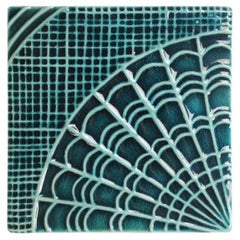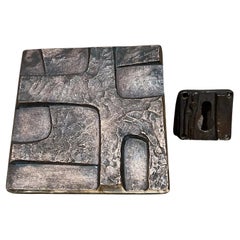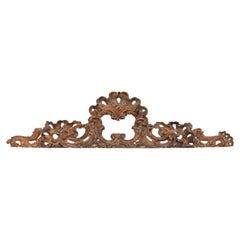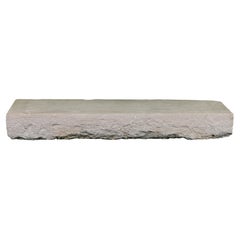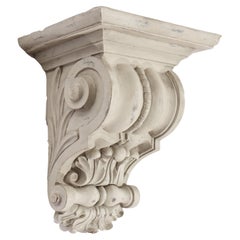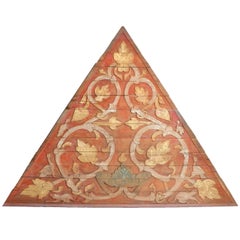Architectural Elements
to
574
1,974
1,564
3,224
388
47
Height
to
Width
to
238
181
135
132
120
109
108
99
94
82
80
63
53
41
37
13
11
5
715
1,279
1,230
435
404
412
226
48
10
87
63
32
70
80
79
14
20
1,258
1,211
923
597
453
2,431
886
553
538
494
3,659
3,414
3,535
60
35
24
20
15
Architectural Elements For Sale
Gaudi Ceramic Tile Hand Painted Colors
By Theia Tiles
Located in Lisbon, PT
Laced blankets, crochet throws and knitted mantles are at the heart of Gaudí. Handmade is the focal point to the Gaudí tile, where soft lines create a we...
Category
2010s European Modern Architectural Elements
Materials
Ceramic
$503 / item
1970s Brutalist Solid Bronze Cast Door Handle Germany
By Paul Evans
Located in Chula Vista, CA
Bronze Brutalist Door Handle Germany
stamped by maker
Door handle 5.75 h x 5.75 w x 2.25 h
Fitting Keyhole Cover 2.25 x 2.25 x .5 d
Original preow...
Category
Late 20th Century German Brutalist Architectural Elements
Materials
Bronze
Late 18th Century Italian Pierce-Carved Wood Pediment Fragment
Located in Atlanta, GA
An Italian carved-wood pediment fragment, with its original finish, from the turn of the 18th and 19th century. This antique wall ornament from Italy...
Category
Early 19th Century Italian Antique Architectural Elements
Materials
Wood
Solid Axel-Vervoordt Style Fireplace Original Reclaimed Base Stone In Limestone
Located in Beervelde, BE
This solid base stone is a striking piece of off-white French limestone, perfect for those who appreciate the timeless elegance of Axel Vervoordt’s aesthetic. The rectangular, reclai...
Category
18th Century French French Provincial Antique Architectural Elements
Materials
Stone, Limestone
Antique French Empire Style Composite Classical Decorative Corbel 20thC
Located in Big Flats, NY
Antique French Empire Style Composite Classical Decorative Corbel 20thC
Measures - 19 1/2" x 16" x 12 1/4"
A French Empire style decorative corbel from mid 20th Century. This classic...
Category
20th Century Architectural Elements
Materials
Composition
$360 Sale Price
20% Off
Teakwood Architectural Temple Pediment
Located in Chicago, IL
This giant architectural element once graced the pediment of a Northern Thai temple. It is from Chiang, Mai, Thailand and entirely made from Teakwood, which is naturally resistant ...
Category
Late 19th Century Thai Antique Architectural Elements
Materials
Teak
$3,750 Sale Price
25% Off
1 of the 38 Unique Antique Relief Tiles with Flower, France, circa 1900
By OTHR
Located in Rijssen, NL
38 stuks Art Nouveau wall tiles with an image of a flower. The dimensions per tile are 5.9inch (15 cm) × 5.9 inch (15 cm).
Please note that the piece is for one piece. 38 pieces ava...
Category
Early 1900s French Art Nouveau Antique Architectural Elements
Materials
Ceramic
Antique Castle Fireplace of french limestone from the 18th century Louis XIII
Located in Made, NL
Very beautiful and robust castle mantelpiece made of French limestone! This antique mantelpiece dates from the 18th century and has a subtle ornament in the middle of the front part ...
Category
18th Century French Other Antique Architectural Elements
Materials
Limestone
Pair of Carved Marble Recumbent Lions
Located in Norwood, NJ
Fine quality antique carved marble recumbent lions after models by Antonio Canova. Architectural elements most likely part of a larger el...
Category
Late 19th Century Italian Antique Architectural Elements
Materials
Carrara Marble
$3,275 / set
Rare 18 Century Full Raised Panel Room Timothy Childs House
Located in Woodbury, CT
18th Century Full Raised Panel Room from the Dr Timothy Child’s house in Pittsfield MA. House dates from mid 18th century. The paneling is a complete room and very rare with the heig...
Category
Mid-18th Century American American Colonial Antique Architectural Elements
Materials
Wood
19th Century Terracotta Garden Lions
Located in Houston, TX
A large opposing pair of Italian mid-19th century terracotta lions. Each lion is raised on a rectangular base. Beautiful expressive faces and wonderfully carved manes with great patina.
Category
19th Century Italian Neoclassical Antique Architectural Elements
Materials
Terracotta
$16,000 / set
Antique Carrara marble fireplace in Pompadour style, 19th century
Located in Made, NL
This elegant antique fireplace, made of refined Carrara marble, comes from France and exudes the charm of the 19th century. With graceful lines and subtle details, it is a timeless v...
Category
19th Century French Other Antique Architectural Elements
Materials
Marble
18th Century Italian Neoclassical Carved Wooden Altar
Located in Buisson, FR
Wonderful neoclassical carved wooden altar with beautiful gilded angels.
Italy, circa 1760-1780. Weathered, small losses and old repairs.
Category
18th Century Italian Neoclassical Antique Architectural Elements
Materials
Wood
$1,882 Sale Price
36% Off
19th Century Trade Sign Clothing Wood Double Sided Wooden Hudson Valley NY
Located in Newfoundland, PA
Take a look at this fantastic double sided early 19th or late 18th century wooden trade sign with original wrought Iron bracket. Came out of a Hudso...
Category
Mid-19th Century American Primitive Antique Architectural Elements
Materials
Iron
Solid brass door pull : Open manifest collection
Located in Marrakech, MA
Use: Indoor or protected outdoor
Inspired by the delicate curve of a crescent moon, the PT/LE/02 door pull is an organic creation from the Open Manifest collection. Entirely handcra...
Category
21st Century and Contemporary Moroccan Organic Modern Architectural Elements
Materials
Brass
Gilded 19th Century Wooden Urn-Shaped Rococo Table Lamp
Located in Copenhagen, K
This 19th century Rococo-style, gilded and painted in blue and red table lamp, featuring an decorative urn shaped body with side handles carved in wood. The lamp is raised on a squar...
Category
19th Century French Rococo Antique Architectural Elements
Materials
Wood
$777 Sale Price
44% Off
Heavy Gothic Lion’s Mask Brass Door Knocker
Located in Godshill, Isle of Wight
Heavy Gothic Lion’s Mask Brass Door Knocker
This is a superb door knocker, the handsome Lion’s Head is at the centre and the heavy outer ring lifts and lands on the striking plat...
Category
1950s Neoclassical Vintage Architectural Elements
Materials
Brass
French 17/ 18th Century Hand Carved Oak Baroque Curl Ornament
Located in Buisson, FR
Beautiful handcarved and natural weathered oak baroque ornament . Was once part of a larger piece.
France, circa 1650-1750. Wonderful weathered condition. Measurement includes the wo...
Category
18th Century French Baroque Antique Architectural Elements
Materials
Oak
$472 Sale Price
46% Off
French Four-Tier Iron Plant Tower, A Pair
Located in Bradenton, FL
Decorative pair of French Four-Tier Iron Plant Towers. Each tower is crafted of wrought iron with a black painted finish. They are designed in a tall, narrow cylindrical form and cro...
Category
Mid-20th Century French Art Deco Architectural Elements
Materials
Iron
Polychromed Classical Styled Carved Garland or Festoon
Located in Nashville, TN
Hand carved wood architectural fragment . Polychromed in colors of gaiety .In style of ancient classical Roman garlands or festoons .
FESTOON CARVED IN WOOD CARVING OF A GARLAND ...
Category
Late 20th Century Italian Classical Roman Architectural Elements
Materials
Wood
$780 Sale Price
20% Off
17th/18th Century French Carved Wooden Lion Head
Located in Buisson, FR
Gorgeous hand-carved wooden lion head with a great patina due to its extreme high age.
France circa 1650-1750
Weathered. measurements include the wooden base.
H:32,5cm W:18,5cm D:1...
Category
17th Century French Rustic Antique Architectural Elements
Materials
Wood
$591 Sale Price
50% Off
Pair of Large Patinated Zinc Architectural Finials Mounted on Iron Bases
Located in Los Angeles, CA
A striking pair of monumental zinc architectural finials, each featuring a tall faceted spire form with a tapered silhouette and twisted metal finial tip. The surfaces display a rich...
Category
19th Century French Industrial Antique Architectural Elements
Materials
Iron, Zinc
Exceptional 18th Century Carved Giltwood Door
Located in New Orleans, LA
Period Louis XIV carved giltwood bow front door. The door is mounted on a piece of wood to preserve its original condition.
Category
Early 18th Century French Louis XIV Antique Architectural Elements
Materials
Giltwood
Early 20th Century Pair of Carved Marble Corbels / Brackets
Located in Stamford, CT
Antique pair of marble corbels in Acanthus Leaf Pattern. This pair is made from solid marble, which have been hand carved with the architectural element of ornate scrolling. The corb...
Category
Early 20th Century American Architectural Elements
Materials
Marble
Pair of Antique French Bronze Curtain Tiebacks or Curtain Holders
Located in Barntrup, DE
A pair of French Rococo-style bronze curtain tiebacks or curtain holders, from the early 1900s.
A beautiful pair of Rococo or Louis XV style bronze cu...
Category
Early 20th Century French Rococo Architectural Elements
Materials
Bronze
19th Century Monumental Black Marble Antique Fireplace Surround
Located in Made, NL
Monumental Louis XVI black marble mantle in excellent condition. A true masterpiece.
The carving is of such a high quality showing the true art of ...
Category
Late 19th Century Belgian Louis XVI Antique Architectural Elements
Materials
Belgian Black Marble
$75,315 Sale Price
21% Off
Decorative Pair of Wooden Light Green and Gold Painted Architectural Finials
Located in Leesburg, VA
Decorative Pair of Wooden Light Green and Gold painted Architectural finials
Anonymous
Probably ate 19th or early 20th century; American in the European style
Painted and gilded pine wood
Approximate size: 18 x 6 in.
The present pair of decorative painted wood architectural finials...
Category
20th Century American Neoclassical Revival Architectural Elements
Materials
Pine
French Style Wrought Iron Greenhouse with Door and Windows in White Color
Located in Marbella, ES
French style wrought iron greenhouse with doors and windows that open outwards. Ready for glass panels to be installed.
Category
2010s French Architectural Elements
Materials
Iron
French Mid Century Aluminum Brise Soleil Sun Shutter Panel by Jean Prouvé 1950s
By Jean Prouvé
Located in Stockholm, SE
Very rare and iconic French architectural mid century aluminum sun shutter / brise soleil by Jean Prouvé with an original chain mechanism inside the gold aluminum frame. In great ori...
Category
1950s French Mid-Century Modern Vintage Architectural Elements
Materials
Aluminum
Pair of Art Deco Wrought Iron Large Sconces
Located in Winter Park, FL
A pair of large Art Deco Spanish Revival style wrought iron architectural sconces with cold-painted finish made to look like bronze. Five half-dome torchiere up-lights create a dramatic effect when lit. Each dome is 7" diameter. Good quality iron work with large rivets and heavy cast iron back plate...
Category
Early 20th Century North American Art Deco Architectural Elements
Materials
Metal, Wrought Iron, Iron
Small Square Antique Fireback / Backsplash
Located in Haarlem, Noord-Holland
Nice and decorative square cast iron fireback / backsplash displaying a female figure doing laundry and other house hold chores.
Great original condition and nice patina.
Can be pla...
Category
19th Century French Antique Architectural Elements
Materials
Iron
$448 Sale Price
20% Off
Antique European Encaustic Cement Tiles. Pre-WWII
Located in Baltimore, MD
Encaustic cement tiles were pioneered by the French in the middle of the 19th century and relied on chemical curing rather than traditional firing. This technique had the advantage ...
Category
1930s Vintage Architectural Elements
Materials
Cement
Handmade Sculptural Iron, Copper, Bronze 4 Piece Railings, by Larry Griffis Sr.
Located in Buffalo, NY
Handmade sculptural iron, copper, bronze 4 piece railings, by Larry Griffis Jr. Stunning artistic railings originally commissioned for downtown Buffalo N...
Category
1970s American Brutalist Vintage Architectural Elements
Materials
Bronze, Copper, Iron
Pair of 1880s Italian Carved Wooden Wall Carvings Depicting Pomegranates
Located in Atlanta, GA
A pair of Italian carved wooden wall carvings from the late 19th century, depicting pomegranates. Created in Italy during the last quarter of the 1...
Category
Late 19th Century Italian Antique Architectural Elements
Materials
Wood
Handmade Houses A Guide to the Woodbutcher's Art by Art Boericke
Located in valatie, NY
Handmade Houses: A Guide to the Woodbutcher's Art by Art Boericke. Scrimshaw Press, California, 1973. 3rd printing hardcover with dust jacket. The book is a photo-journey through the...
Category
1970s American Vintage Architectural Elements
Materials
Paper
Carved and Painted Wooden Eagle with Shield Attributed to John Haley Bellamy
Located in Savannah, GA
In all original untouched condition including weathered paint, this wonderful Folk Art wall plaque speaks for itself. Substantial size. It looks to be made to be mounted on a ledge, ...
Category
Mid-19th Century American Federal Antique Architectural Elements
Materials
Wood
$9,713 Sale Price
24% Off
Rare Hand Carved Stone Wellhead Cistern Basin Antique Fountain Focal Point LA CA
Located in West Hollywood, CA
Rare hand carved stone Wellhead cistern Basin Antique Fountain Focal point LA CA. 19th Century Neogothic Water Wellhead hand carved stone planter Basin ...
Category
19th Century French Gothic Revival Antique Architectural Elements
Materials
Stone, Limestone, Iron, Wrought Iron
$93,750 Sale Price
25% Off
Vintage English Country Cast Brass Equestrian Horse Door Knocker
Located in Elkhart, IN
A gorgeous cast brass equestrian horse and horseshoe door knocker.
USA, Late 20th Century
Measures: 4"W x 2.88 "D x 5.88"H.
Very good vintage condition.
Category
Late 20th Century American Country Architectural Elements
Materials
Brass
Countertop Faucet with Hot and Cold Valves by Andrew de Freitas
Located in São Paulo, BR
Important Note: This piece was designed according to Brazilian hydraulic standards but can be adapted to other international standards. Before completing your purchase, please contac...
Category
21st Century and Contemporary Brazilian Architectural Elements
Materials
Brass
19th Century Hand Painted Wood Puto Architectural Element
Located in Douglas Manor, NY
1850 Carved polchromed and gilt wood puto architectural element
Category
19th Century Antique Architectural Elements
Materials
Giltwood
Sculptural Bronze Door Handle with Abstract Design
Located in London, GB
A sculptural bronze push or pull door handle with abstract relief. Germany, second half 20th century (probably 1970s).
A heavy piece, made of cast metal, with very nice changing ton...
Category
Late 20th Century German Mid-Century Modern Architectural Elements
Materials
Bronze
19th Century Wrought Iron Lunette or Fan Light
Located in Baltimore, MD
Arched ironwork features landed and riveted components. Metal work is structurally sound with no losses.
Category
1880s Antique Architectural Elements
Materials
Wrought Iron
Two Modernist Panels of Wrought Iron Railings, Gates or Screens Mid 20th Century
Located in London, GB
Two modernist panels of wrought iron - railings, gates or screens. Mid-20th century, found in Sweden.
Striking modernist design of folded triangles and rods finished in black paint....
Category
Mid-20th Century Swedish Mid-Century Modern Architectural Elements
Materials
Iron
Pair of Antique French Renaissance Style Carved Wood Architectural Wall Panels
Located in Houston, TX
Great pair of well carved French Renaissance style or French Baroque style relief carved architectural walnut wooden panels or fragments from the 19th century.
These beautifully carv...
Category
19th Century French Greco Roman Antique Architectural Elements
Materials
Wood
Tall Pair of Pine and Brass Obelisks, 1970's
Located in Bainbridge, NY
Pair of Knotty Pine Obelisks, Circa 1960's. Featuring three solid panels of smooth, adhesed Knotty Pine with thin tipped pyramidal apex, atop 1.25H balanced square Brass box, bases ...
Category
1970s American Mid-Century Modern Vintage Architectural Elements
Materials
Brass
Large Late 17th Century Baroque Iron Door Lock
Located in Haddonfield, NJ
Large French baroque wrought iron door lock on acrylic stand.
Category
Late 17th Century French Baroque Antique Architectural Elements
Materials
Wrought Iron
$650 Sale Price
48% Off
6+ Ft. Tall Antique Carved Architectural Lintel Beam from Central Asia on Stand
Located in Atlanta, GA
An early 20th century carved wood support beam from central Asia, custom mounted on iron stand. This antique wooden support beam was once a lintel which adorns the upper doorway of a...
Category
20th Century Central Asian Architectural Elements
Materials
Iron
Set of Six Sherle Wagner Ribbon and Reed Cabinet Drawer Pulls
Located in Fort Lauderdale, FL
Set of six Sherle Wagner ribbon and reed cabinet drawer pulls in brass/bronze gold finish. Like new condition. Price is for the set of six. Sherle...
Category
Late 20th Century Rococo Revival Architectural Elements
Materials
Bronze
$1,225 Sale Price / set
30% Off
Wrought iron balustrade
Located in COULLONS, FR
Wrought iron balustrade
- price is per unit
- Width excluding fixings is 98.5cm
- One piece weighs approximately 9Kg
Category
Late 19th Century French Antique Architectural Elements
Materials
Wrought Iron
$274 / item
Architecture of the Old South: Louisiana by Mills Lane
Located in valatie, NY
Architecture of the Old South: Louisiana by Mills Lane. New York: A Beehive Press book or Abbeville Press, 1990. First edition hardcover with dust jacket. 203 pp. The book has chapters on: The Colony, Federal Era...
Category
1990s American Architectural Elements
Materials
Paper
Timeless French Limestone Fireplace Mantel
Located in Haarlem, Noord-Holland
Nice French Campagnard style fireplace mantel in lovely limestone.
This mantel comes from central France, burgundy area.
Its perfect size makes it possible to install this mantel in ...
Category
19th Century French Antique Architectural Elements
Materials
Stone, Limestone, Marble
Hand Carved Stone Finial Architectural Element Medici Urn Center Piece Antiques
Located in West Hollywood, CA
Hand Carved Stone Finial Architectural Element Medici Urn Center Piece Antiques . Early 1800’s Hand Carved Stone Medici finial. to mount on garden post by a gate or simply using it ...
Category
Early 19th Century French Antique Architectural Elements
Materials
Stone
$7,840 Sale Price
20% Off
Set of 4 Italian Rococo Painted Carved Columns
Located in Queens, NY
Set of 4 Italian Rococo (17th/18th Century) green painted columns with gold swirl carved floral design and Corinthian capitals.
Category
Late 17th Century Italian Rococo Antique Architectural Elements
Materials
Wood
$145,000 / set
An Antique Architectural Carved Stone Fragment From Aragon Spain On Custom Stand
Located in Atlanta, GA
An 18th to 19th century carved stone architectural fragment from Aragon, Spain. This antique architectural fragment from Aragon has been hand-carved of stone, featuring a raised shield-shaped design with curvy outline about it's perimeter, and is nicely presented upon on a custom black iron base. The stone has a fabulous patina with weathering, and some areas of wear and slight losses, showing it's rich history and prior use. This 18th to 19th century Spanish carved stone fragment...
Category
18th Century Spanish Antique Architectural Elements
Materials
Stone
Pair of French Bronze and Brass Curtain Tiebacks or Curtain Holders, ca. 1920
Located in Barntrup, DE
A beautiful pair of antique bronze and brass curtain holders or tie-backs with very nice Louis XVI-style decorations. France, circa 1920.
Dimensions: Height 30 cm / 11.81 in; width 4...
Category
1920s French Louis XVI Vintage Architectural Elements
Materials
Brass, Bronze
French Style Wrought Iron Greenhouse with Door and Windows in Green Color
Located in Marbella, ES
French style wrought iron greenhouse with doors and windows that open outwards in white color. Ready for glass panels to be instal...
Category
2010s French Architectural Elements
Materials
Iron
Mid 20th Century Stained Glass Windows Fruit & Leaves, Jewels
Located in Port Jervis, NY
Fabulous set of 4 leaded and stained glass windows. Excellent craftsmanship and design in the framework of these 4 windows. Red cherrie...
Category
1950s American Art Nouveau Vintage Architectural Elements
Materials
Lead
Antique Large Moroccan Moorish Antique Ryad Studded Door 19th C.
Located in Moreno Valley, CA
Antique massive handcrafted Hispano Moresque studded doorway, incredible work, very heavy authentic Moroccan door.
One door inside a larger door.
19th ...
Category
19th Century Moroccan Moorish Antique Architectural Elements
Materials
Iron
$10,000 Sale Price
20% Off
1 of the 42 Art Nouveau Tiles, by Gilliot Hemiksem, Belgium, circa 1930's
By Gilliot
Located in Rijssen, NL
1 of the 60 Art Nouveau ceramic tiles by Gilliot Fabrieken Hemiksem, Belgium, circa 1930. Beautiful original antique tiles with a chrysanthemum in relief. The tile shows a soft yello...
Category
Early 20th Century Belgian Art Nouveau Architectural Elements
Materials
Ceramic
Antique mantle surround of French limestone from the 18th century, Louis XV
By Rustic Design
Located in Made, NL
18th Century Louis XV Limestone Fireplace Mantel from France
This elegant 18th-century Louis XV fireplace mantel is hand-carved from antique French limestone, showcasing the timeles...
Category
18th Century French Other Antique Architectural Elements
Materials
Limestone
Still Thinking About These?
All Recently ViewedMore Ways To Browse
Iron Balcony Railing
Iron Corbels
Iron Greenhouse
Lightning Rod
Monastery Doors
Romanesque Capital
Used Stair Railings
15th Century Architectural Fragment
15th Century Coffer
Antique Lightning Rod
Antique Plaster Corbels
Art Deco Grill
Chinese Green Tiles
Copper Corbels
Figural Corbels
French Devres Tile
French Wrought Iron Railing
Gothic Salvage
